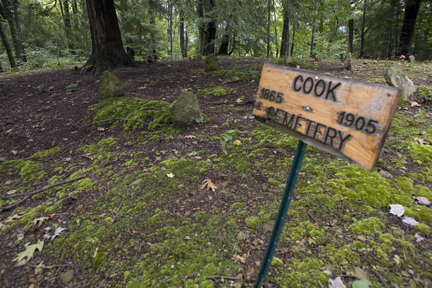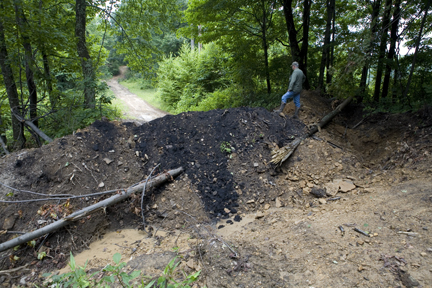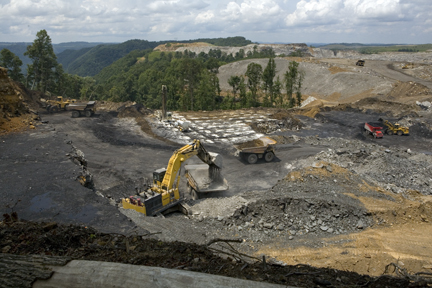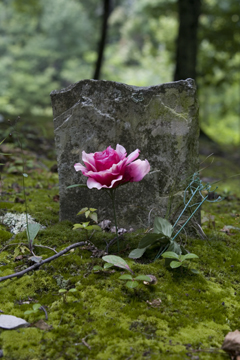
Cook Cemetery To Be Swallowed By Coal?
James Creek, WV –The emails started rolling into my e-mail box Sunday afternoon. Cook Cemetery up James Creek in Boone County–just over the other side of Bolt Mountain from the Coal River Valley along Route 85 which winds along Pond Fork — was in the midst of being swallowed up. At least six road blocks made of fallen trees and mud had been pushed by bulldozers up Cook Mountain Road, the only access to these three Cook family cemeteries. Three separate cemeteries contain one, twenty-seven, and two graves, in total, 29 lives buried on the top of Cook Mountain.
I met up with Marvin White, a 57 year old retired underground Union miner. White led me up to the site. “I worked 25 years at Eastern Associated. But I am completely against this, what is going on here,” he told me, as we walked along deeply rutted muddy roads to the graves. White said he must have kin up in these cemeteries, ” the Whites married with the Cook family years and years ago,” he said.
Over about a one mile walk along the ridge, we climbed up and over the machine-made mud berms across the road — at a few of them, two foot wide, four feet deep trenches had been dug down the slope on either side of the road. “That’s so four wheelers can’t pass,” White told me.

A great clamor and hissing of machines rushed up the mountainside from the north. We now stood about seventy-five yards from the largest of the three Cook family cemeteries. Turning left, about fifty feet north, we came upon what can be locally described as another “Hell’s Gate,” a term used by Larry Gibson and all those that make that trek to the border of Gibson family land and Patriot Coal’s massive mountaintop removal site on Kayford Mountain. White and I stood on the edge of a certain kind of Hell…
Directly beneath us, about 500 feet below, we saw machines and men filling holes with fertilizer, preparing for a blast; end-loaders dumping coal into waiting trucks; a line of swiftly moving Yukes–the bulldozers with wheels 24 feet high–cruising towards the latest blast site to retrieve loads of crumbled mountaintop. An active mountaintop removal mine site buzzed away, just below a cemetery.

Directly above and behind us, about 300 yards maximum, we can see the edge of the road at the cemetery. From the rate the trucks are moving on this mine site, there will be a blast here Tuesday afternoon.

White told me that he keeps an eye out around here and listens to the radio waves. Last year, White heard the workers talking about a blast ready to go, near a cemetery. ” I heard them one day bragging. It about made me sick. They was talking about this blast they laid–and it was a big one–and they said, ‘hey, What are those people down there gonna think about that! Gonna be ghosts coming out of that ground!”
William Chapman “Chap” Cook was born on 14 December, 1840. He served three years in the Civil War and served with the First Company of the West Virginia Calvary. Cook is buried alone on Cook Mountain. The headstone is in excellent condition; a border of rock covered by soft moss encloses his grave and now, so does a chain link fence. “Otherwise, people won’t know there’s a grave here!,” said White.
Does Cook, a Civil War veteran, deserve a place to rest or does Horizon Resources have the right to push his grave into a valley while no one is looking?
White told me how he knew these woods like the back of his hand. He told me how there’s a huge sludge pond at the head of Jarrells Branch, near where he lives. Then he told me a story. He told me about some bear tracks he once saw. Tracks that walked towards the sludge pond. White described the pond’s edge to be about 4 feet of thick gooey tar.
“You could see the bear tracks walkin in…he didn’t know any better… You could see his steps going deeper and deeper and then, you couldn’t see anything at all. I looked everywhere, all around, for tell of that bear. I believe he sunk, that bear drowned in that coal pond.”
Link to Permit for Cook Mountain surface mine site
